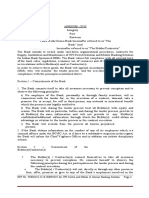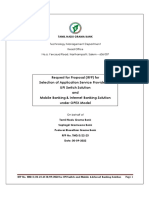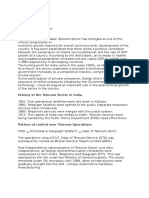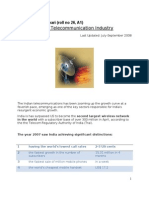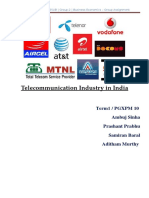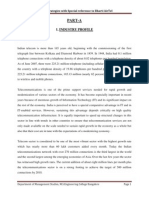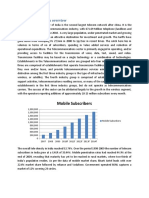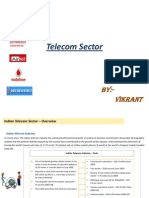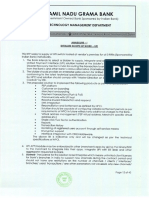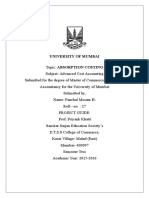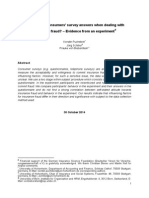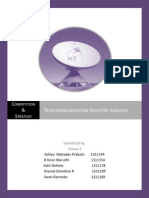Print Release - Attachment
Print Release - Attachment
Uploaded by
Karan PanchalCopyright:
Available Formats
Print Release - Attachment
Print Release - Attachment
Uploaded by
Karan PanchalOriginal Description:
Original Title
Copyright
Available Formats
Share this document
Did you find this document useful?
Is this content inappropriate?
Copyright:
Available Formats
Print Release - Attachment
Print Release - Attachment
Uploaded by
Karan PanchalCopyright:
Available Formats
9/10/13
Print Release
Press Information Bureau Government of India Ministry of Communications & Information Technology
23-December-2011 16:20 IST
Indian Telecom Sector Growth: an International Success Story 870 Million Connections Added Against Target of 600 Million During 11th Plan Overall Teledensity Exceeds 76 Per Cent Over 97 Per Cent Villages Connected Through VPTs Customers Get Options For Mobile Number Portability and Commercial Communications Preferences Draft National Telecom Policy- 2011 Announced
Year End Review Deptt. of Telecommunications
The Indian Telecom sector has proved to be an international success story. The sector has witnessed a commendable growth over the past two years. With an overall subscriber base of 914.60 million and a teledensity of 76.03%, the sector continues to grow from strength to strength. With the urban teledensity reaching 166.54%, the market has been showing signs of maturity. Rural India is the key target market likely to drive the next round of growth, particularly for voice based services. It is envisaged that rural teledensity of 40% would be reached by end of 2014. 3G and BWA are expected to reinvigorate the maturing urban markets and help in bringing balanced growth of economy. The aggressive growth observed by mobile services is yet to be replicated in case of broadband service, where the subscriber base currently stands at more than 12 million. The Government has a vision to provide telephone connection and broadband facilities on demand across the country at an affordable price and it strives to achieve the same. The growth of telecom sector since 2007: Subscribers Wireline Wireless Total Phones Internet Broadband Subscribers' base ( in million) March'07 40.77 165.09 205.87 9.21 2.29 March'08 39.41 261.08 300.49 11.05 3.81 March'09 37.96 391.76 429.73 13.65 6.22 March'10 36.96 584.32 621.28 16.10 8.77 March'11 34.73 811.60 846.33 19.69 11.79 381.40 October'11 33.19 881.41 914.60 12.84* -
Data services/ Wireless 31.3 65.5 117.82 177.87 internet# # accessing internet through wireless networks as per quarterly reports of TRAI *up to September 2011 .
The 11th plan (2007-2012) had envisaged provision of 600 million connections. The number of telephone connections both wireline and wireless put together stands at 914.60 million on 31.10.2011. This registers an addition of 869.83 million connections by October 2011 against a target of 600 million connections by end of the
pib.nic.in/newsite/PrintRelease.aspx 1/6
9/10/13
Print Release
12th Plan i.e. March 2012. Wireless subscribers increased to 881.41 million by October 2011, exhibiting a Compound Annual Growth Rate (CAGR) of 43.93% . During the first seven months of the current year 2011-12, the wireless connections grew by 8.60%. The number of Internet subscribers grew by 22.30%, while the broadband subscribers grew at 34.43% during the year 2010-11. Change in composition of sector: Public vs. Private: The liberalization efforts of the Government are evident in the growing share of the private sector. The private sector is now playing an important role in the expansion of telecom sector which is evident from the following table: Number of Telephones ( in million) Year 2007 PSUs' Network Wireline 37.46 Wireless 33.93 Total 71.39 Private Network Wireline 3.31 Wireless 131.16 Total 134.48 Total 205.87 %age Share of PSUs' 34.68% %age Share of PSUs' 26.47% 20.84% 17.04% 14.89% 14.08%
Number of Telephones ( in million) Year 2008 2009 2010 2011 October'11 PSUs' Network Wireline 35.23 32.92 31.33 28.69 26.99 Wireless 44.32 56.63 74.54 97.31 101.82 Total 79.55 89.55 105.87 126.00 128.81 Private Network Wireline 4.19 5.04 5.63 6.04 6.20 Wireless 216.76 335.13 509.78 714.29 779.59 Total 220.94 340.18 515.38 720.33 785.79 Total 300.49 429.73 621.28 846.33 914.60
The share of private sector in the number of telephones has increased from 65.32% (134.48 million telephones) at the end of March, 2007 to 85.92% (786 million telephones) at the end of October, 2011.
Wireless vs. Wireline : The preference for use of wireless phones has also been predominant in the sector. This is confirmed from the rising share of wireless phones, which increased from 80.19% (165.09 million) at the end of March, 2007 to 96.37% (881.41 million) at the end of October, 2011.
Trend in Teledensity: Teledensity in the country is steadily increasing from 18.22% as on 31.3.07 to 70.89% as on 31.03.11 and currently stands at 76.03% as on 31.10.11. However, there is a wide gap between urban teledensity (166.54%) and rural teledensity (36.81%). Rural Telephony: 97.09% of the villages in India have been covered by the Village Public Telephones (VPTs). Apart from the 308.87 million connections provided in the rural areas, 576350 VPTs have been provided till 31.10.2011. Policy Reforms and New Initiatives
pib.nic.in/newsite/PrintRelease.aspx 2/6
9/10/13
Print Release
For a dynamic sector, reforms are necessitated by dynamics of changes including technological innovations. The telecom sector in India has been witnessing a continuous process of reforms since 1991. During the recent years, various policy initiatives have been carried out to give boost to the sector. Major policy initiatives and milestones achieved in Telecom Sector include: A Mobile Number Portability (MNP):
MNP was launched by the Prime Minister on January 20, 2011. The MNP service allows subscribers to retain their existing mobile telephone number even when they switch from one access service provider to another irrespective of mobile technology or from one technology to another technology of the same or any other access service provider within the same service area. Implementation of MNP has not only given wider choices to the Indian subscribers but has also induced service providers to offer innovative, affordable and competitive traffic plans for the benefit of the masses. As on November 30, 2011, 19 million mobile customers have successfully ported their mobile numbers to the service providers of their choice. B Telecom Commercial Communications Customer Preference Regulations 2010:
Telecom Commercial Communications Customer Preference Regulations (TCCCPR) 2010 came into force on September 27, 2011. TCCCPR 2010 gives options to customers to exercise their preference, separate number for telemarketers starting with 140, easy registration of the telemarketers, sharing of database, blacklisting provisions, filtering of calls and SMS by service providers, effective complaint redressal system and financial disincentive on access providers. In order to curb unsolicited commercial communication, which were a major cause of disturbance and inconvenience for telecom users, TRAI notified Telecom Unsolicited Commercial Communication Regulations in 2007, putting in place a framework for controlling unsolicited commercial communications. This regulation was further improved through two amendments in 2008. As a result of this regulation, the number of unsolicited calls decreased but the number of unsolicited SMS increased. The Indian telecom customer demanded more from TRAI, which led to enforcement of TCCCPR 2010. C Foreign Direct Investment (FDI):
Foreign Direct Investment (FDI) is one of the important sources to meet the requirement of huge funds for rapid network expansion. The FDI policy provides an investor-friendly environment for the growth of the telecom sector. Telecom has emerged as the third major sector attracting FDI inflows after services and computer software sector. At present, 74% to 100% FDI is permitted for various telecom services. This investment has helped telecom sector to grow. The growth of FDI in Telecom Sector since 2007 is as under: Foreign Direct Investment(in million US$) 2007-08 2008-09 2009-10 2011-12 1261 2558 2554 1665
2006-07 FDI D 478 Declining Tariff:
2011-12 (upto Sept. 2011) 1901
The telephone tariffs have declined dramatically over the last two years making the mobile telephone affordable to the common man. There are a large number of options available for the subscribers to choose from the market depending upon their usage profile. The prepaid tariffs have gone as low as paise per second. E Manufacturing of Telecom Equipment:
The exponential growth witnessed by the telecom sector in the past decade has led to the development of the telecom equipment manufacturing and other supporting industries. With the advent of next-generation technologies and operators looking to roll out 3G and broadband wireless access services, the demand for
pib.nic.in/newsite/PrintRelease.aspx 3/6
9/10/13
Print Release
telecom equipment has increased rapidly. In an attempt to capitalize on this opportunity, the Government is focusing on developing the domestic manufacturing industry. The Indian equipment manufacturing sector has come a long way in the past few years. From being an import-centric industry, it is slowly but steadily moving towards becoming a global telecom equipment manufacturing hub. In 2002-03, India produced telecom equipment worth Rs 144 billion, which increased to Rs 520 billion in 2010-11, making a growth of 265 per cent. One of the key reasons for this trend is the setting up of domestic manufacturing facilities by Indian companies along with multinational companies. The market is currently dominated by multinational companies like Nokia, Nokia Siemens Networks, Ericsson, Alcatel-Lucent, Motorola, LG Electronics, Samsung etc. which have set up their production facilities in the country over the past decade and many more are planning to set up. Also, with Indian as well as multinational companies setting up base in India, the country is not only emerging as a manufacturing hub but is also planning to increase its telecom exports. In the year 2006-07, India exported equipment worth Rs 18.98 billion, which increased by over 730 per cent to Rs 158 billion in 2010-11. Indian mobile handset companies increased their share in the domestic market to 14 per cent in 2009-10 from 3-4 per cent in 2008-09. Domestic brands have established themselves in the market and are competing with international handset vendors. The Government is supporting the domestic equipment manufacturing industry and the growth of indigenous technology. With efforts from both the Government and the industry, India can build a conducive ecosystem to boost the equipment manufacturing sector, which can lead to the creation of an industry that will compete with the best in the world. With above initiatives India is expected to be a manufacturing hub for telecom equipment. F Draft National Telecom Policy(NTP 2011): Draft NTP 2011 was announced on October 10, 2011. NTP2011 proposes to provide stable, rationale and objective policy regime over next decade or so: o To make available secure, reliable and affordable voice telephony and high speed broadband services to every citizen in India with special focus on rural and remote areas. o To improve the broadband experience by enhancing the speed of delivery. o To make India a global hub of manufacturing for all electronic products including telecom equipment with substantial value addition within the country and safeguard security concerns of the nation. o For simplification and rationalisation of licensing regime, transparent system for allocation of spectrum and enable efficient usage of spectrum. o For discovery of price of spectrum through market related processes. o To achieve One Nation- Full Mobile Number Portability o To enable free roaming throughout the country. o To harness full potential of mobile phones for enabling provision of citizen centric services related to education, health, employment, agriculture, entertainment, banking & insurance services, skill upgradation, vocational training etc. o To encourage indigenous manufacture of cost effective mobile devices. The faster roll out of high speed and reliable broadband in rural and urban areas will enable decentralised governance, participative democracy and delivery of basic services such as health and education to every citizen of the country. The thrust on manufacturing will promote entrepreneurship, create more job opportunities, reduce imports and improve security. Efficient usage of scarce resources like spectrum will result in better quality of service to the customers at affordable cost. The new policy regime will be beneficial to end consumers/citizens, Telecom Service Providers, Value Added Service Providers, Government and Manufacturers. Policy is likely to be approved by the June 2012. National frequency Allocation Plan:
G.
The National Frequency Allocation Plan-2011 (NAFP) came into effect from October 1, 2011 to ensure its efficient and effective management. Radio spectrum is becoming increasingly important for all walks of life and needs to be managed rationally. NAFP-2011 is a policy document which contains spectrum allocation for various radio communication services/applications in different frequency bands. This document provides the basis for development,
pib.nic.in/newsite/PrintRelease.aspx 4/6
9/10/13
Print Release
manufacturing and spectrum utilization activities in the country, both for Government and private sectors. H Recent initiatives undertaken by USOF:
The strategy for network expansion in rural areas mainly involves provision of phones in the viable areas through market mechanism and through Universal Service Obligation Fund (USOF) in the non-viable areas. While Village Public Telephones (VPTs) will enable public access, a scheme of Infrastructure sharing by Infrastructure Providers and Universal Service Providers has been launched under USOF to create infrastructure in rural and remote areas. The achievements of the schemes under USOF are as under: Apart from the 308.87 million connections provided in the rural areas, 576350 VPTs have been provided till 31.10.11. 97.09% of the villages in India have now been covered by the VPTs. As on 30.10.2011, 7289 towers i.e. about 99% have been set up under shared mobile infrastructure scheme . The infrastructure so created is being shared by three service providers for provision of mobile services. As on 30.09.2011, a total of 2,24,631 broadband connections have been provided and 5674 kiosks have been set up in rural and remote areas under Rural Broadband Scheme for expanding provision of Wireline Broadband Connectivity upto village level. Another Scheme has been launched to provide sufficient back-haul capacity to integrate the voice and data traffic from the access network in the rural areas to their core network by strengthening the OFC network. This scheme considers Optical Fibre Cable (OFC) Network augmentation between the blocks' HQ and Districts' HQ to begin with. USOF, through this Scheme, shall provide subsidy support for augmentation, creation and management of intra-district SDHQ-DHQ OFC Network on the condition that it will be shared with other Telecom Operators at the rates prescribed in the Agreement. Assam has been taken up first for implementation.
Some of the pilot projects undertaken by USOF are as under:(i) Support is being provided for mobile charging stations in 5000 villages through Tata Energy Research Institute ( TERI) project of Lighting a Billion Lives (LaBL). The solar mobile charging stations in these 5000 villages are to be provided in a phased manner over a period of two years from the date of signing of the Agreement. Till 30.04.2011, mobile charging stations have been established in 322 villages. (ii) A Memorandum of Understanding (MoU) has been signed with BSNL for financial support from USOF for provision of Broadband enabled Rural Public Service Terminals (RPSTs) to eligible Woman SHGs (Self Help Groups) on pilot basis in the states of HP and Rajasthan. BSNL shall provide an RPST to one eligible SHG from each of its eligible rural wire-line exchanges under the MoU as per agreed terms & conditions with subsidy support from USO Fund. At present, 150 RPSTs (100 in Rajasthan and 50 in HP) have been provided under this scheme. (iii) Recognizing the vital role that Information Communication Technology (ICT) can play in the empowerment of rural women, a scheme has been launched for pilot projects aimed at facilitating Self Help Groups (SHGs) access to ICT enabled services. Financial support from USO Fund is to be provided towards Value Added Service (VAS) subscriptions for SHGs in accordance with the provisions of underlying subsidy Agreements. At present MoUs have been signed for Proof of Concept (PoC) for 8 mobile VAS projects in the state of Tamilnadu, Kerala, Maharashtra, Uttar Pradesh, Uttarakhand, Andhra Pradesh, Rajasthan and the Union Territory of Puducherry. I Implementation of National Optical Fibre Network (NOFN): All village Panchayats are to be connected through NOFN to enable delivery of public and private electronic services to citizens in urban and rural areas. Broadband is a tool for improving the life of people by providing affordable and equitable access to information and knowledge. For individual, broadband has direct impact on their day to day life style and behaviour. For State, it enormously contributes towards trade and generation of employment. o Many Information and Communication Technologies (ICT) applications such as e-commerce, e-banking, e-governance, e-education and tele-medicine require high speed Internet connectivity.
pib.nic.in/newsite/PrintRelease.aspx 5/6
9/10/13
Print Release
Government has approved National Optical Fiber Network in October 2011 for providing Broadband connectivity to all Panchayats at a cost of approx 20,000 Crore. o The plan is to extend the existing optical fiber network up to Panchayats. The Network will be available to telecom service providers for providing various services to the citizens in nondiscriminatory manner. As per the approval of the Cabinet, the action for establishing and operationalising Special Purpose Vehicle (SPV) has been initiated for management and operation of the NOFN and ensuring non-discriminatory access to all service providers. In economic terms, the benefits from the scheme are expected through additional employment, eeducation, e-health, e-agriculture etc. and reduction in migration of rural population to urban areas. As per a study conducted by the World Bank, with every 10% increase in broadband penetration, there is an increase in GDP growth by 1.4%. o NOFN will also facilitate implementation of various e-governance initiatives such as e-health, e-banking, e-education etc. thereby facilitating inclusive growth. o The Network will provide a highway for transmission of voice, data and video in rural areas. It will enable the broadband connectivity upto 2 Mbps, capable of providing various electronic services like education, health, entertainment, commerce etc; to people and businesses. The people in rural areas, student, entrepreneurs, various Government Departments providing services under e-gov projects will be benefitted. It will also provide connectivity to various public institutions like Gram Panchayats, Primary Health Centres (PHCs), schools etc. in rural areas. It will also result in investment from the private sector both for providing different services and manufacturing of broadband related telecom equipment. The NOFN project would be implemented in 2 years.
SP/AT/ska
pib.nic.in/newsite/PrintRelease.aspx
6/6
You might also like
- Brand Management ProjectDocument37 pagesBrand Management Projectanindya_kundu67% (6)
- Scope Annexure As Per RFPDocument15 pagesScope Annexure As Per RFPKaran PanchalNo ratings yet
- Integrity Pact & SLADocument21 pagesIntegrity Pact & SLAKaran PanchalNo ratings yet
- TNGB TMD RFP 3 22-23 30092022Document95 pagesTNGB TMD RFP 3 22-23 30092022Karan PanchalNo ratings yet
- RFP No. TMD/3/22-23 DT 30/09/2022 For UPI Switch and Mobile & Internet Banking SolutionDocument4 pagesRFP No. TMD/3/22-23 DT 30/09/2022 For UPI Switch and Mobile & Internet Banking SolutionKaran PanchalNo ratings yet
- National Payments Corporation of India NACH Project: June, 2020Document10 pagesNational Payments Corporation of India NACH Project: June, 2020Karan Panchal100% (2)
- NACH File Process For BanksDocument24 pagesNACH File Process For BanksvigneshNo ratings yet
- Research Project On Airtel AdsDocument28 pagesResearch Project On Airtel Adskapil50% (2)
- Indian Telecom IndustryDocument33 pagesIndian Telecom IndustryTarun Daga100% (4)
- Bharti Airtel Cases Study IIMKDocument19 pagesBharti Airtel Cases Study IIMKprofvelu200950% (4)
- Ramya Mba ProjectDocument103 pagesRamya Mba ProjectSudha Swetha100% (1)
- Internship ReportDocument85 pagesInternship ReportSunita SinghNo ratings yet
- TelecomDocument3 pagesTelecomNaveen GidaveerNo ratings yet
- TelecomDocument3 pagesTelecomNaveen GidaveerNo ratings yet
- Value-Added Services (VAS) MarketDocument5 pagesValue-Added Services (VAS) MarketsabbathmailerNo ratings yet
- Telecom Industry in India: Sonal Thakur Leave A Comment Go To CommentsDocument11 pagesTelecom Industry in India: Sonal Thakur Leave A Comment Go To CommentsaarudharshanNo ratings yet
- Telecom Industry in IndiaDocument6 pagesTelecom Industry in IndiaTwinkle SuriNo ratings yet
- Value-Added Services (VAS) MarketDocument6 pagesValue-Added Services (VAS) MarketSwaraj Singh DhanjalNo ratings yet
- Telecommunications: Value-Added Services (VAS) MarketDocument9 pagesTelecommunications: Value-Added Services (VAS) MarketsachintodurNo ratings yet
- Value-Added Services (VAS) MarketDocument5 pagesValue-Added Services (VAS) MarketmsankardasNo ratings yet
- CommunicationanalysisbsnlDocument72 pagesCommunicationanalysisbsnlmanwanimuki12No ratings yet
- MTNL Company Analysis - 121746638Document27 pagesMTNL Company Analysis - 121746638ishanNo ratings yet
- Indian Telecom IndustryDocument12 pagesIndian Telecom IndustryGaurav SinghNo ratings yet
- BHARTIDocument44 pagesBHARTIisuzeNo ratings yet
- The Indian Telecom StoryDocument17 pagesThe Indian Telecom Storypriyankkothari123No ratings yet
- Current Trends in Indian Telecom: 1. New Players Entering Rural MarketsDocument7 pagesCurrent Trends in Indian Telecom: 1. New Players Entering Rural MarketsRishabh KantNo ratings yet
- Indian Telecom Sector GrowthDocument2 pagesIndian Telecom Sector Growthsrimba11No ratings yet
- Annual Report 2010-11 (Department of Telecommunications)Document154 pagesAnnual Report 2010-11 (Department of Telecommunications)Ashish ThakurNo ratings yet
- Bharath Full ProjectDocument81 pagesBharath Full ProjectRavi KumarNo ratings yet
- Contemporary Issues in ManagementDocument25 pagesContemporary Issues in ManagementShreyansh ShahNo ratings yet
- Indian Telecom Industryairtelhr 1229853424192363 2Document35 pagesIndian Telecom Industryairtelhr 1229853424192363 2Pranav ChudjiNo ratings yet
- Industry Profile: Customer Satisfaction Towards Reliance TelecommunicationDocument74 pagesIndustry Profile: Customer Satisfaction Towards Reliance TelecommunicationPramodr PramodNo ratings yet
- Indian Telecom Sector-June 2010Document7 pagesIndian Telecom Sector-June 2010Tonya HowardNo ratings yet
- Telecommunication in IndiaDocument23 pagesTelecommunication in IndiaAnmol SaxenaNo ratings yet
- Mba ProjectDocument46 pagesMba ProjectsatishNo ratings yet
- Complete Project1Document101 pagesComplete Project1Sanjay PatelNo ratings yet
- Report On Brand Image of Nokia MobileDocument14 pagesReport On Brand Image of Nokia MobileMuhammed MusthafaNo ratings yet
- Customer Satisfaction On JioDocument75 pagesCustomer Satisfaction On JioPrince Kumar0% (1)
- Telecom IndustryDocument3 pagesTelecom Industrytanus03No ratings yet
- Indian Telecom IndustryDocument35 pagesIndian Telecom Industrymini244100% (4)
- Executive SummaryDocument20 pagesExecutive SummaryShubham GuptaNo ratings yet
- Fundamental AnalysisDocument20 pagesFundamental AnalysisRitu Walia100% (1)
- Business Economics Group PGXPM 10 Group2 AssignmentDocument9 pagesBusiness Economics Group PGXPM 10 Group2 AssignmentambujsinhaNo ratings yet
- Industry Profile: Part-ADocument78 pagesIndustry Profile: Part-AAnees AnsariNo ratings yet
- Telecom Sector: Industry OverviewDocument4 pagesTelecom Sector: Industry OverviewPradeep GuptaNo ratings yet
- Introduction To Telecom IndustryDocument3 pagesIntroduction To Telecom IndustrySanketBhalodia100% (1)
- Introduction To Telecom IndustryDocument8 pagesIntroduction To Telecom Industryshabad_sharma564No ratings yet
- AP G T S I C: Resentation ON THE Rowth OF Elecom Ector IN Ndia AND HallengesDocument46 pagesAP G T S I C: Resentation ON THE Rowth OF Elecom Ector IN Ndia AND Hallengesneha23prestigeNo ratings yet
- Sector Compendium Oct2013Document68 pagesSector Compendium Oct2013Abhishek SinghNo ratings yet
- Introduction To Service IndustryDocument25 pagesIntroduction To Service IndustryRAGHAVENDRA1010100% (9)
- Project Report-Reliance Communications-Customer SatisfactionDocument57 pagesProject Report-Reliance Communications-Customer Satisfactionyash mittal82% (49)
- Screenshot 2023-10-02 at 9.13.30 PMDocument30 pagesScreenshot 2023-10-02 at 9.13.30 PMAakriti GuptaNo ratings yet
- Analysis and Interpretation of Data 3.1 Indian Telecom SectorDocument16 pagesAnalysis and Interpretation of Data 3.1 Indian Telecom SectorKaran AroraNo ratings yet
- Overview of Telecom IndustryDocument7 pagesOverview of Telecom Industrysaba khanNo ratings yet
- Mobile Subscribers: Telecom Industry: An OverviewDocument5 pagesMobile Subscribers: Telecom Industry: An Overviewpgp25107No ratings yet
- Overview of Telecom Industry I) Growth Over Last Few YearsDocument6 pagesOverview of Telecom Industry I) Growth Over Last Few Yearsray92100No ratings yet
- Telecom SectorDocument12 pagesTelecom Sectorjeet_singh_deepNo ratings yet
- Advertising Effectiveness On Telecom Ind - ProjectDocument51 pagesAdvertising Effectiveness On Telecom Ind - Projecttina_18No ratings yet
- Industry Profile/Company Profile 3.1 Industry Profile:: Brand Awareness of AirtelDocument39 pagesIndustry Profile/Company Profile 3.1 Industry Profile:: Brand Awareness of AirtelSushma BanerjeeNo ratings yet
- Strategic Management AirtelDocument11 pagesStrategic Management AirtelKush AsherNo ratings yet
- Industry Analysis of Telecom Sector1Document34 pagesIndustry Analysis of Telecom Sector1Animesh100% (1)
- Executive Summary: Indian Tele-CommunicationsDocument50 pagesExecutive Summary: Indian Tele-CommunicationsAsim OlakfNo ratings yet
- Chapter I - Industry AnalysisDocument9 pagesChapter I - Industry AnalysisANUSHANo ratings yet
- Papers on the field: Telecommunication Economic, Business, Regulation & PolicyFrom EverandPapers on the field: Telecommunication Economic, Business, Regulation & PolicyNo ratings yet
- Cellular Technologies for Emerging Markets: 2G, 3G and BeyondFrom EverandCellular Technologies for Emerging Markets: 2G, 3G and BeyondNo ratings yet
- Wireless Telecommunications Carrier Revenues World Summary: Market Values & Financials by CountryFrom EverandWireless Telecommunications Carrier Revenues World Summary: Market Values & Financials by CountryNo ratings yet
- Cellular & Wireless Telecommunication Revenues World Summary: Market Values & Financials by CountryFrom EverandCellular & Wireless Telecommunication Revenues World Summary: Market Values & Financials by CountryNo ratings yet
- Age of Mobile Data: The Wireless Journey To All Data 4G NetworksFrom EverandAge of Mobile Data: The Wireless Journey To All Data 4G NetworksRating: 4.5 out of 5 stars4.5/5 (5)
- Annexures I IIDocument1 pageAnnexures I IIKaran PanchalNo ratings yet
- Upi TXN Count April 2022 BankwiseDocument143 pagesUpi TXN Count April 2022 BankwiseKaran PanchalNo ratings yet
- Upi MB NB Po FinacusDocument40 pagesUpi MB NB Po FinacusKaran PanchalNo ratings yet
- Chat 2Document1 pageChat 2Karan PanchalNo ratings yet
- Process COmplaince Form Signed 2Document1 pageProcess COmplaince Form Signed 2Karan PanchalNo ratings yet
- Legal ClausesDocument10 pagesLegal ClausesKaran PanchalNo ratings yet
- Scope TMGDocument11 pagesScope TMGKaran PanchalNo ratings yet
- Amendment RFP 3 22-23 30-09-2022Document14 pagesAmendment RFP 3 22-23 30-09-2022Karan PanchalNo ratings yet
- NDA - Signed - Mobile BankingDocument7 pagesNDA - Signed - Mobile BankingKaran PanchalNo ratings yet
- Scope of WorkDocument13 pagesScope of WorkKaran PanchalNo ratings yet
- SHRADDocument6 pagesSHRADKaran PanchalNo ratings yet
- Ima Icici AccontsDocument79 pagesIma Icici AccontsKaran PanchalNo ratings yet
- Mahanagar CO OP BANKDocument28 pagesMahanagar CO OP BANKKaran PanchalNo ratings yet
- Planning Project Business: A SWOT Analysis, With Its Four Elements in A 2×2 MatrixDocument10 pagesPlanning Project Business: A SWOT Analysis, With Its Four Elements in A 2×2 MatrixKaran PanchalNo ratings yet
- University of Mumbai Project On Co-Operative SocietyDocument6 pagesUniversity of Mumbai Project On Co-Operative SocietyKaran PanchalNo ratings yet
- Can We Trust Consumers' Survey Answers When Dealing With Insurance Fraud? - Evidence From An ExperimentDocument37 pagesCan We Trust Consumers' Survey Answers When Dealing With Insurance Fraud? - Evidence From An ExperimentKaran PanchalNo ratings yet
- SHRADDocument6 pagesSHRADKaran PanchalNo ratings yet
- Thakur Institute of Management Studies and ResearchDocument19 pagesThakur Institute of Management Studies and ResearchKaran PanchalNo ratings yet
- B M Locations FY 2012-2013 List On Location As Per Register (PSD) Location Name Location NoDocument5 pagesB M Locations FY 2012-2013 List On Location As Per Register (PSD) Location Name Location NoKaran PanchalNo ratings yet
- Marketing Management: On Airtel - Magic'Document6 pagesMarketing Management: On Airtel - Magic'Rahul RavindranathanNo ratings yet
- Indian Telecom SectorDocument40 pagesIndian Telecom Sectoragrawalrohit_228384No ratings yet
- Telecom Sector in GujaratDocument68 pagesTelecom Sector in Gujaratnishutha3340No ratings yet
- A Comaparive Study of Customer Satisfaction of Airtel and Vodafone As Service Providers in Delhi and NCR Region.Document82 pagesA Comaparive Study of Customer Satisfaction of Airtel and Vodafone As Service Providers in Delhi and NCR Region.Pia ThompsonNo ratings yet
- TELECOM INDUSTRY FinalDocument25 pagesTELECOM INDUSTRY FinalShameek ChakrabortyNo ratings yet
- Telecom Industry AnalysisDocument23 pagesTelecom Industry AnalysisSachin Gupta100% (9)
- Customer Satisfaction and Expectation Towards Aircel: A Research Conducted in West MidnaporeDocument14 pagesCustomer Satisfaction and Expectation Towards Aircel: A Research Conducted in West MidnaporenaguficoNo ratings yet
- Telecommunication Industry: by Kalpana Dwivedi Taduri Srilatha Arnab Dawn Tushar ShuklaDocument27 pagesTelecommunication Industry: by Kalpana Dwivedi Taduri Srilatha Arnab Dawn Tushar ShuklaArnab DawnNo ratings yet
- Jio 2Document5 pagesJio 2Apoorva PattnaikNo ratings yet
- Fundamental AnalysisDocument20 pagesFundamental AnalysisRitu Walia100% (1)
- A Comparative Study On Airtel and Reliance JioDocument72 pagesA Comparative Study On Airtel and Reliance Jioanika gulatiNo ratings yet
- Telecom Industry IndiaDocument14 pagesTelecom Industry IndiaAbhishek SinghNo ratings yet
- ADocument78 pagesATushar PandeyNo ratings yet
- Project Completion Certificate: Demand in India" Is Successfully Done by Mr. Gangasagar Amula During The IVDocument59 pagesProject Completion Certificate: Demand in India" Is Successfully Done by Mr. Gangasagar Amula During The IVHilal LoneNo ratings yet
- Teracom Mehta Bhavesh 2013151Document3 pagesTeracom Mehta Bhavesh 2013151Mehtabhavesh19No ratings yet
- Database Management and Payment Processing - AirtelDocument114 pagesDatabase Management and Payment Processing - AirtelSTAR PRINTINGNo ratings yet
- BSNL Unlimited GB Broadband Plans: Unlimited (BSNL N/W) Rs.225 Free Calls Unlimited Free Calls ToDocument1 pageBSNL Unlimited GB Broadband Plans: Unlimited (BSNL N/W) Rs.225 Free Calls Unlimited Free Calls Topine appleNo ratings yet
- Presentation To To Board For Reconstruction of Public Sector Enterprise (BRPSE)Document33 pagesPresentation To To Board For Reconstruction of Public Sector Enterprise (BRPSE)desinet1No ratings yet
- BSNL Strategic PlanningDocument93 pagesBSNL Strategic PlanningRowdy HbkNo ratings yet
- Postpaid Churn Analysis of Idea Cellular LTD (Punjab Circle)Document60 pagesPostpaid Churn Analysis of Idea Cellular LTD (Punjab Circle)amitkayenatNo ratings yet
- Airtel ProjectDocument56 pagesAirtel Projectsakshi_malik_1987No ratings yet
- Mobile Vas - Tcs Project ReportDocument51 pagesMobile Vas - Tcs Project ReportRohit PNo ratings yet
- India's Telecommunication Network Is The Second Largest in The World Based On The Total Number ofDocument1 pageIndia's Telecommunication Network Is The Second Largest in The World Based On The Total Number ofDevNo ratings yet
- 7 P'S of Telecom IndustryDocument23 pages7 P'S of Telecom IndustryYogesh Jain0% (1)
- Blue Ocean Strategy Telecom IndustryDocument3 pagesBlue Ocean Strategy Telecom IndustryVivek KwatraNo ratings yet


